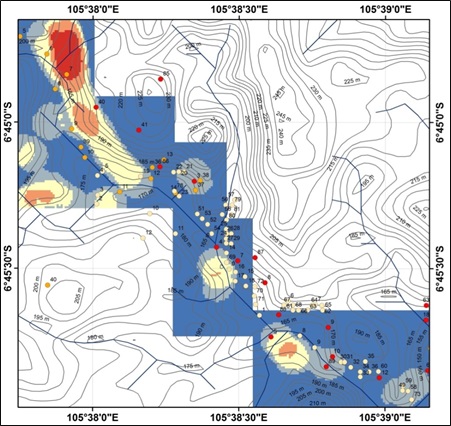Rock Formation Acid Mine Drainage in Epithermal Gold Mineralization, Pandeglang, Banten Province
DOI:
https://doi.org/10.25299/jgeet.2019.4.4.3903Keywords:
Acid Mine Drainage, Ephitermal gold, Sulphide Minerals, Source Rock, CibaliungAbstract
Mine acid water is acidic water and contains iron and sulfate, which is formed under natural conditions when geological strata containing pyrites are exposed to an oxidizing atmosphere or environment. One of the impacts of the mineralization zone where there is a mining process is the potential for the formation of acid mine drainage, especially in the Cibaliung gold mineralization area and its surroundings, Pandeglang Regency, Banten Province. Acid-forming sulfide minerals include pyrite (FeS2), headquarters (FeS2), picoliters (FexSx), calcocytes (CuS), covellite (CuS), chalcopyrite (CuFeS2), molybdenite (MoS), mulenite (NiS), chalocytes (CuS), covellite (CuS), chalcopyrite (CuFeS2), molybdenite (MoS), mulenite (NiS), chalocytes (CuS), covellite (CuS), chalcopyrite (CuFeS2), molybdenite (MoS), mulenite (NiS), galena (PbS) ) and sphalerite (ZnS). Of all these minerals, pyrite is the most dominant sulfide in acid formation.
Alkaline mine water (alkaline mine drainage) is mine water that has an acidity level (pH) of 6 or more, containing alkalinity but still containing dissolved metals that can produce acids. The quality of mine water, acid or alkali, depends on the presence or absence of acid mineral content (sulfides) and alkaline materials in the geological strata.
Acid water formation tends to be more intensive in mining areas. This can be prevented by avoiding exposure to sulfide-containing materials in the free air. Acid-forming sulfide minerals include pyrite (FeS2), headquarters (FeS2), picoliters (FexSx), calcocytes (CuS), covellite (CuS), chalcopyrite (CuFeS2), molybdenite (MoS), mulenite (NiS), chalocytes (CuS), covellite (CuS), chalcopyrite (CuFeS2), molybdenite (MoS), mulenite (NiS), chalocytes (CuS), covellite (CuS), chalcopyrite (CuFeS2), molybdenite (MoS), mulenite (NiS), galena (PbS) ) and sphalerite (ZnS). Of all these minerals, pyrite is the most dominant sulfide in acid formation. Formation of potential acidic water also occurs in tailings which are residues/processing residues containing sulfide minerals. The formation of acid mine drainage does not always develop in every sulfide-ore mining. In certain types of ore deposits, there are neutralizing agents which prevent the formation of acid mine drainage.
Downloads
References
DudiNasrudin Usman, Nana Sulaksana, FebriHirnawan, Iyan Haryanto. 2018. Gold-Silver Mineralization in the Neo-Tectonism of Honje Formation and Cipacar Formation, in Cibaliung Block, Banten Province. Journal of Geoscience, Engineering, Environment and Technology. Vol. 3 No. 4 2018. DOI: 10.24273 / jgeet.2018.3.4.1852
Sayoga, R. G. 2007. Mine Water Management: Important Aspects in Mining with Environmental Insights. Scientific Speech, assembly of ITB Professors. Department of Mining Engineering ITB.
Wijanyanti, Retno. 2002. Oxidation of Ferrous Ion in Mine Water with Iron-Oxidizing Bacteria. Mineral Technology Research and Development Center, Bandung

Downloads
Published
Issue
Section
License
Copyright @2019. This is an open-access article distributed under the terms of the Creative Commons Attribution-ShareAlike 4.0 International License which permits unrestricted use, distribution, and reproduction in any medium. Copyrights of all materials published in JGEET are freely available without charge to users or / institution. Users are allowed to read, download, copy, distribute, search, or link to full-text articles in this journal without asking by giving appropriate credit, provide a link to the license, and indicate if changes were made. All of the remix, transform, or build upon the material must distribute the contributions under the same license as the original.










